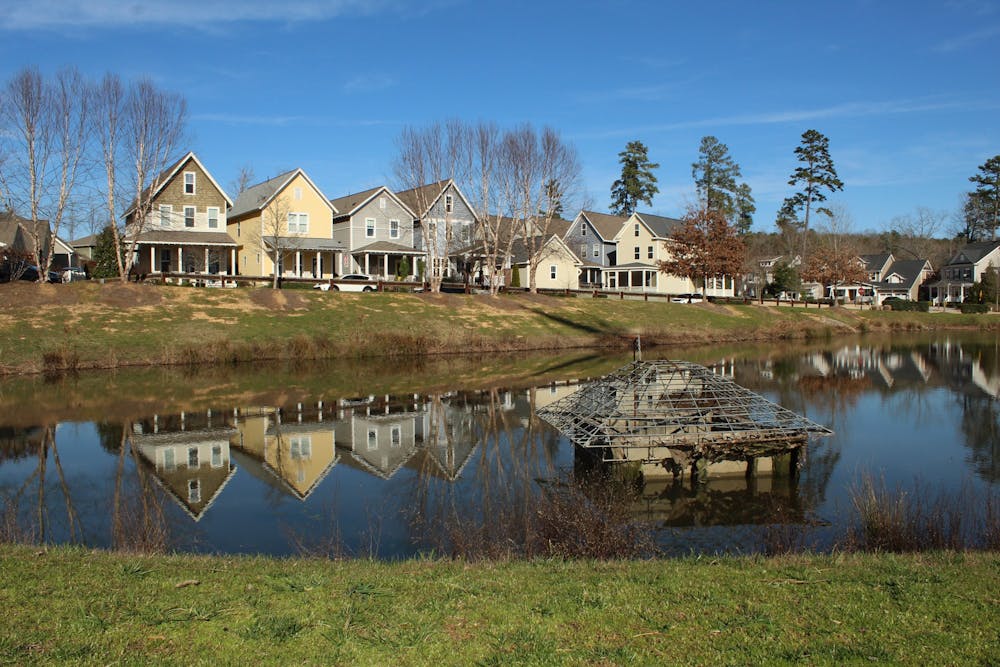ONSWC acquired the Briar Chapel wastewater treatment plant in 2015. Its other assets include the wastewater treatment plant in Fearrington Village, a community on the other side of the highway, which they acquired in 2017 for $1.
Bill Grantmyre, an attorney for the NCUC Public Staff, which helps consumers resolve disputes with utilities companies, said with the transfer of ownership, the Briar Chapel Treatment Plant will expand its operations and take advantage of the discharge permit available at the Fearrington Village site.
“What they want to do is combine the two systems and have a regional wastewater treatment plant in the Briar Chapel,” Grantmyre said. “They would pump all the collected wastewater from Fearrington Village to the Briar Chapel treatment plant and have it treated there, and then also either spray it on the Briar Chapel reclaimed water spray fields or deposit it into the tributary of Jordan Lake under the (National Pollutant Discharge Elimination System) discharge permit that’s been issued to Fearrington Utilities that would be transferred to Chatham North.”
Under the NPDES permit, the Fearrington Village facility is allowed to discharge 500,000 gallons per day of treated water into a tributary of Jordan Lake. By acquiring the Fearrington Village assets, ONSWC-Chatham North would be able to utilize the permit to minimize the amount of water sprayed in Briar Chapel and instead discharge it from Fearrington Village by means of a pipeline connecting the two facilities.
“We are concerned that the reason they want this Fearrington facility is that this Fearrington facility has a permit to discharge treated wastewater back into the watershed for (Jordan Lake),” Field said. “Since we drink (Jordan Lake) water, we’re concerned about continuing to increase the nutrient levels going into that Haw River watershed.”
Increased nutrient levels from substances like wastewater in bodies of water can lead to toxic algal blooms. However, Francis DiGiano, UNC professor emeritus in the Department of Environmental Sciences and Engineering, said by email the relative amount of nutrients in the discharged wastewater would have little impact in the lake, which holds 15 billion gallons of water.
What comes next?
In a statement to The Daily Tar Heel, Lee Bowman, an officer at Envirolink, said the forecasted growth of Briar Chapel demands an updated water reclamation system. The updated plant would include a system that uses microfilters in the wastewater treatment process.
“Its interconnection with the Fearrington Village water reclamation system will also allow the combined system to be a better steward to the environment by reducing nutrient levels and as well as more efficient operations for the communities,” Bowman said.
In a testimony before the utilities commission, Michael Myers, the president of ONSWC-Chatham North and Envirolink, said measures would be taken to reduce odors, such as filtration screens and covering sewage operations.
A public hearing scheduled for Jan. 22 regarding the transfer of ownership of facilities was canceled by the utilities commission. Grantmyre said the commission Public Staff requested for it to be rescheduled 150 days later, allowing time for Envirolink to resolve its issues and for the concerned residents to gather information needed to make their case.
Field said the residents did not know the extent of the issues until a transition of membership on the Briar Chapel Community Association, which until December had been composed largely of officers of the community’s developer, Newland Real Estate Group. He also said Newland and their contractors are largely to blame for the faulty infrastructure that has contributed to the problems.
To get the day's news and headlines in your inbox each morning, sign up for our email newsletters.
“Well, I think combining facilities would be a good idea, and we’re not opposed to a regional wastewater treatment plant to support development in this area,” Field said. “What we’re opposed to is leaving it in the middle of the neighborhood. I think there are probably locations in other parts of Briar Chapel. I think it needs to be closer to 15-501.”
@henryhaney17
@DTHCityState | city@dailytarheel.com



